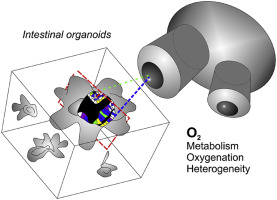当前位置:
X-MOL 学术
›
Biomaterials
›
论文详情
Our official English website, www.x-mol.net, welcomes your
feedback! (Note: you will need to create a separate account there.)
Live cell imaging of mouse intestinal organoids reveals heterogeneity in their oxygenation
Biomaterials ( IF 12.8 ) Pub Date : 2017-09-03 , DOI: 10.1016/j.biomaterials.2017.08.043 Irina A. Okkelman , Tara Foley , Dmitri B. Papkovsky , Ruslan I. Dmitriev
Biomaterials ( IF 12.8 ) Pub Date : 2017-09-03 , DOI: 10.1016/j.biomaterials.2017.08.043 Irina A. Okkelman , Tara Foley , Dmitri B. Papkovsky , Ruslan I. Dmitriev

|
Intestinal organoids are widely applied in stem cell research, regenerative medicine, toxicology, pharmacology, and host-microbe interactions research. The variability of oxidative metabolism for stem and differentiated cell types constituting organoid is known to be important but so far it has not been studied in details. Here, we report the use of live cell microscopy of oxygen via the phosphorescence lifetime imaging microscopy (PLIM) method to address the oxygenation and variability of aerobic metabolism of individual organoids in the culture. Using the cell-penetrating phosphorescent O2-sensitive probe, we found inhomogeneous O2 distribution in live organoids, with areas of relatively high oxygenation (up to 73 μM in organoid compared to an average 40 μM O2) and trans-epithelial O2 microgradients (up to 0.6–0.83 μM/μm). We also demonstrated that intestinal organoid culture consists of units with different respiration activity and oxygenation (from 27 to 92 μM, equal to 2.8–9.7% O2), depending on age of the culture and drug treatment. Collectively, our results indicate that ignoring the metabolic heterogeneity of organoid culture can be critical for proper data interpretation. The live cell imaging PLIM method demonstrates a clear advantage of using individual organoids as separate experimental units rather than ‘bulk’ organoid cultures.
中文翻译:

小鼠肠道类器官的活细胞成像揭示了其氧合的异质性
肠道类器官被广泛应用于干细胞研究,再生医学,毒理学,药理学和宿主-微生物相互作用研究。已知对于构成类器官的干细胞和分化细胞类型而言,氧化代谢的变异性很重要,但到目前为止,尚未对其进行详细研究。在这里,我们报道了通过磷光寿命成像显微镜(PLIM)方法使用氧气的活细胞显微镜来解决培养物中单个类器官的氧合和有氧代谢的变异性。使用穿透细胞的磷光O 2敏感探针,我们发现活的类器官中的O 2分布不均匀,具有相对较高的氧合区域(类器官中的最高为73μM,而平均水平为40μMO 2))和反上皮O 2微量梯度(最高0.6–0.83μM/μm)。我们还证明了肠道类器官培养物由具有不同呼吸活性和氧合作用的单元组成(从27到92μM,等于2.8–9.7%O 2),具体取决于培养物的年龄和药物治疗的情况。总的来说,我们的结果表明,忽略类器官培养的代谢异质性对于正确的数据解释至关重要。活细胞成像PLIM方法展示了使用单独的类器官作为单独的实验单位而不是“大量”类器官培养物的明显优势。
更新日期:2017-09-04
中文翻译:

小鼠肠道类器官的活细胞成像揭示了其氧合的异质性
肠道类器官被广泛应用于干细胞研究,再生医学,毒理学,药理学和宿主-微生物相互作用研究。已知对于构成类器官的干细胞和分化细胞类型而言,氧化代谢的变异性很重要,但到目前为止,尚未对其进行详细研究。在这里,我们报道了通过磷光寿命成像显微镜(PLIM)方法使用氧气的活细胞显微镜来解决培养物中单个类器官的氧合和有氧代谢的变异性。使用穿透细胞的磷光O 2敏感探针,我们发现活的类器官中的O 2分布不均匀,具有相对较高的氧合区域(类器官中的最高为73μM,而平均水平为40μMO 2))和反上皮O 2微量梯度(最高0.6–0.83μM/μm)。我们还证明了肠道类器官培养物由具有不同呼吸活性和氧合作用的单元组成(从27到92μM,等于2.8–9.7%O 2),具体取决于培养物的年龄和药物治疗的情况。总的来说,我们的结果表明,忽略类器官培养的代谢异质性对于正确的数据解释至关重要。活细胞成像PLIM方法展示了使用单独的类器官作为单独的实验单位而不是“大量”类器官培养物的明显优势。











































 京公网安备 11010802027423号
京公网安备 11010802027423号